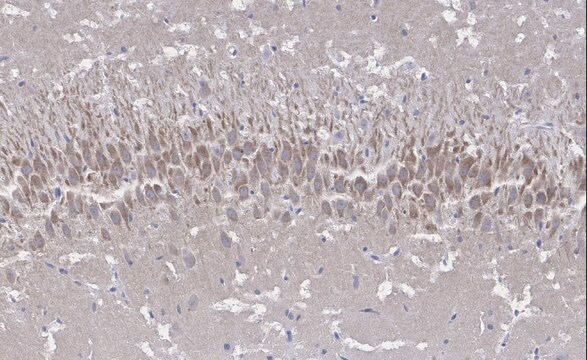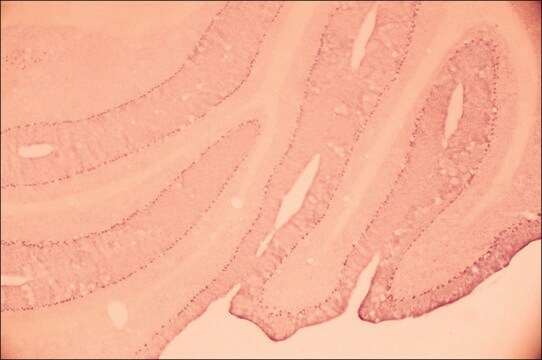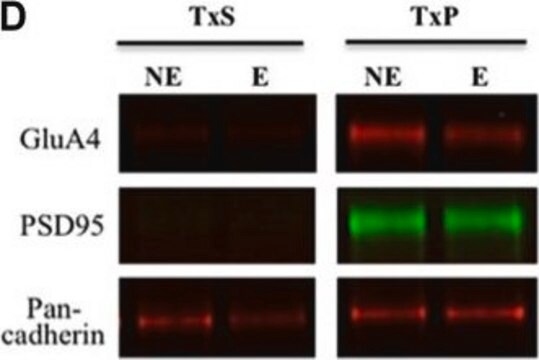推薦產品
生物源
rabbit
品質等級
共軛
unconjugated
抗體表格
affinity isolated antibody
抗體產品種類
primary antibodies
無性繁殖
polyclonal
形狀
buffered aqueous solution
分子量
antigen 100 kDa
物種活性
rat, human
濃度
~1 mg/mL
技術
direct ELISA: suitable
immunohistochemistry: suitable
immunoprecipitation (IP): suitable
western blot: 1:1,000 using rat brain (hippocampal) homogenate
UniProt登錄號
運輸包裝
dry ice
儲存溫度
−20°C
目標翻譯後修改
phosphorylation (pSer831)
基因資訊
human ... GRIA1(2890)
rat ... Gria1(50592)
一般說明
AMPA is a transmembrane receptor for glutamate that regulates synapsis in the central nervous system. It is composed of 4 types of subunits, GluR1, 2, 3, 4.
GluR1 subunits of AMPA receptors are membrane proteins that regulate synaptic plasticity of the central nervous system. This receptor has also been implicated in spatial memory retention. Phosphorylation of serine 831 in GluR1 subunit of the AMPA receptor modulates long-term potentiation in neuronal synapses. Anti-phospho-AMPA Receptor, GluR1 Subunit (pSer831) antibody is specific for the GluR1 subunit (phosphorylated on serine 831) of the AMPA receptor in rats and humans.
免疫原
The GluR1 sequence is conserved among species and has partial homology to VGLUT2.
synthetic phosphopeptide corresponding to a region near serine 831 of rat glutamate receptor subunit GluR1.
應用
Anti-phospho-AMPA Receptor, GluR1 Subunit (pSer831) antibody is suitable for use in direct ELISA, immunohistochemistry, immunoblot and immunoprecipitation. The antibody may also be used for western blot (1:1,000 using rat hippocampal homogenate).
外觀
Solution in 10 mM HEPES buffer, pH 7.5, containing 150 mM NaCl, 100 μg/ml BSA and 50% glycerol.
免責聲明
Unless otherwise stated in our catalog or other company documentation accompanying the product(s), our products are intended for research use only and are not to be used for any other purpose, which includes but is not limited to, unauthorized commercial uses, in vitro diagnostic uses, ex vivo or in vivo therapeutic uses or any type of consumption or application to humans or animals.
未找到適合的產品?
試用我們的產品選擇工具.
儲存類別代碼
10 - Combustible liquids
水污染物質分類(WGK)
WGK 1
閃點(°F)
Not applicable
閃點(°C)
Not applicable
分析證明 (COA)
輸入產品批次/批號來搜索 分析證明 (COA)。在產品’s標籤上找到批次和批號,寫有 ‘Lot’或‘Batch’.。
Hey-Kyoung Lee et al.
Cell, 112(5), 631-643 (2003-03-12)
Plasticity of the nervous system is dependent on mechanisms that regulate the strength of synaptic transmission. Excitatory synapses in the brain undergo long-term potentiation (LTP) and long-term depression (LTD), cellular models of learning and memory. Protein phosphorylation is required for
Hey-Kyoung Lee et al.
Journal of neurophysiology, 103(1), 479-489 (2009-11-13)
Activity-dependent changes in excitatory synaptic transmission in the CNS have been shown to depend on the regulation of alpha-amino-3-hydroxy-5-methyl-4-isoxazole propionic acid receptors (AMPARs). In particular, several lines of evidence suggest that reversible phosphorylation of AMPAR subunit glutamate receptor 1 (GluR1
Hiago Murilo Melo et al.
Molecular neurobiology, 58(4), 1859-1870 (2021-01-07)
The central autonomic network, which is connected to the limbic system structures including the amygdala (AMY) and anterior hippocampus (aHIP), regulates the sympathetic and parasympathetic modulation of visceromotor, neuroendocrine, pain, and behavior manifestations during stress responses. Heart rate variability (HRV)
Xiang Cai et al.
Nature neuroscience, 16(4), 464-472 (2013-03-19)
The causes of major depression remain unknown. Antidepressants elevate concentrations of monoamines, particularly serotonin, but it remains uncertain which downstream events are critical to their therapeutic effects. We found that endogenous serotonin selectively potentiated excitatory synapses formed by the temporoammonic
Loukia Parisiadou et al.
Nature neuroscience, 17(3), 367-376 (2014-01-28)
Leucine-rich repeat kinase 2 (LRRK2) is enriched in the striatal projection neurons (SPNs). We found that LRRK2 negatively regulates protein kinase A (PKA) activity in the SPNs during synaptogenesis and in response to dopamine receptor Drd1 activation. LRRK2 interacted with
我們的科學家團隊在所有研究領域都有豐富的經驗,包括生命科學、材料科學、化學合成、色譜、分析等.
聯絡技術服務




